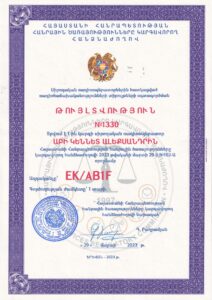
When I realized one day while reviewing my amateur radio logs that I had only a single EK (Armenia) QSO in my AB1F and VU2ABE logs combined– and that too unconfirmed – a thought crossed my mind that I should try and obtain an EK callsign to operate from that country. Not that it would help my AB1F and VU2ABE logs, but I could enable other stations around the world to get not only a QSO with Armenia but also a QSL (traditional card or modern-day electronic confirmation). The main reason I longed to operate from Armenia was that I have been in love with that country and its people from my first visit there in 2006. I have been visiting almost every year since, except for the pandemic gap.
And most importantly, I knew that a friend of mine had a vacant house in a small town called Stepanavan, about 140 kilometers (90 miles) from the hustle and bustle (and electromagnetic interference) of the capital of Yerevan. And I happened to mention my vague plan to my ham friend Ike – W3IKE, who was immediately enthusiastic. Not only that, he promised to donate a Kenwood TS-570S for my use while there and for the hams of Armenia at the end of my expedition. With that kind of support, I could not but try to see if I could actually get an Armenian license. From the ARRL website I got hold of the FRRA (Federation of Radiosport of the Republic of Armenia) and sent them a feeler.
I did not have to wait long. Haik – EK1RR got in touch with me and helped transcribe my application into Armenian for the government department. I was prepared to give it several months but, only about ten days later, Haik informed me that my license had been approved. The next day Haik sent me a scanned image of the license. I was immediately hooked. It is definitely the most beautiful ham license in the world. More like a prestigious award than a mere license. I did not waste any time. I booked my air tickets the very next day for travel in two weeks.
The fact that there was an ongoing armed conflict between Armenia and Azerbaijan at Artsakh (Karabakh) did not deter me. Nor a war farther afield. Nor the presence of Russian soldiers in Armenia. But I was advised, and rightly so, to bring into the country only inconspicuous wire antennas in preference to high visibility beam antennas. This sounded like something straight out of Graham Greene or John le Carré. But I heeded the advice and the tower that had been constructed ahead of my arrival stayed horizontal on this trip.
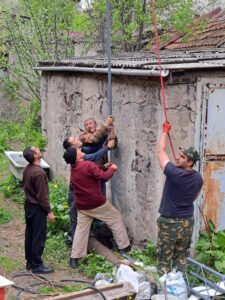
I arrived with three wire antennas – a fan dipole, a G5RV, and an End-Fed – and two transceivers, the Kenwood TS-570S from Ike – W3IKE and my own trusted Yaesu FT-900AT. I foolishly hoped to be on the air on the very day of my arrival. But it took almost a week. The contractor and his team brought in 4 cm (1.5”) metal pipes and welding equipment onsite and cut and welded the pipes to extend the height to about 9 meters (27 feet). With the stainless-steel pulleys and sturdy paracord I had brought with me the antennas were up in a jiffy once the poles were done. Some of the scenes of the antenna hoisting reminded me of iconic pictures of a bygone days in the Far East.
While collecting odds and ends for the trip I had picked up a tape measure. I vividly remember Ike – W3IKE saying, “It’s in feet.” The significance of that statement came to me only in the middle of the antenna installation when I took out the tape to check the dipole lengths. The dumbfounded looks on the faces of the antenna crew told me better than in words that they had never heard of this unit of measure before! Needless to say, I went metric after that.
Though I was thrilled that the antennas were up, I realized right away that there were problems. It was immediately clear that all three antennas had high SWRs. And I had not brought with me either an antenna analyzer or an external antenna tuner. (I had a misplaced faith in commercially manufactured no-tune antennas, but not anymore.) Fortunately, the built-in tuners of the transceivers came to my rescue. But in a strange kind of way the antenna that one of them could tune would not tune on the other and vice versa! I never figured that out.
Oh, the joy of getting on the air to call, “CQ CQ CQ this is Echo Kilo Stroke Alpha Bravo One Foxtrot! The high SWR notwithstanding, I knew my signals were going out because of the immediate barrage of responses that I received. And it affirmed the purpose of my trip – to give as many stations as possible a chance to get EK in their logs at no cost at all except return postage if they wanted a card direct.
The exhilaration soon had a reality check. I learned on the first day itself that the Babel of languages did not all have a single word for “/”. “Stroke” would work with one set of language speakers, while “Slash” would work better with another. And there were some who could not comprehend either. Sometimes “Separation” came to my aid. But there were several instances (too many for comfort) where even after five minutes we did not make any headway, much to the chagrin of other stations waiting in the wings.
The confusion did not end there. A good percentage of the callers were unable to handle the lack of a numeral after “EK” and would invent one. Usually it was “1” but there were instances where it was “7” (I suspect from misinterpreting “Stroke”).
Surprisingly the nation that had no problems with getting the “/” right was Russia. I learned early on that «дробь» (“drob”) was the Russian word for “/” and from that time on «Елена Киловатт Дробь Анна Борис Один Федор» (“Elena Kilowatt drob Anna Boris Odin Fedor”) worked like magic. Not even once did I have to struggle with getting “/” across to Russian stations.
The same could not be said of propagation. Three out of the thirty-one days I got to operate were total washouts and on nine other days I barely broke into double digits. In spite of that, with 75 watts (on account of the SWR) and wire antennas I made 1,826 QSOs while working remotely on my day job (yes, it was a working expedition!) for an average of 59 QSOs per day. Not surprisingly, the bulk of the QSOs were with Europe, with Germany and Italy both topping the 250 mark. But I was fortunate to make QSOs also with North America, South America, Africa, Japan, and a few other countries of Asia.
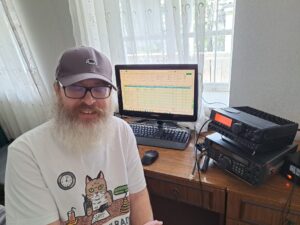
In the second week at Stepanavan I received an email from a Russian ham in Armenia (Dimitriy Zakharov – EK/RX3DPK) expressing a wish to meet me in person. Considering the global situation today, I was honestly a little hesitant. But I need not have worried. Amateur radio transcends all barriers. Dima traveled all the way to Stepanavan and brought his antenna analyzer along, which instrument confirmed that the SWRs were closer to 10 than 1. It is a miracle how the 25-year-old Yaesu FT-900AT tuned them enough to get a signal out. Before returning to Yerevan, Dima presented me with a homebrew balun he had made himself. In the next few days after his return to Yerevan, Dima and I tried to have a QSO so we could add EK to our respective logs, but without success. Our locations being too close we were in skip with each other on HF.
The eagerness of DX stations to have a QSO with my EK station was only to be expected, but what surprised me was the familiarity of some of the DX stations with Armenia. There was an amateur radio operator from Poland who had done relief work decades ago in the town of Spitak after the devastating earthquake of 1988. There was another from Germany who had traveled overland to Armenia years earlier and still remembered the roads around Stepanavan. There were a few others who had visited Armenia as tourists and fondly recalled the flavorful Armenian food that they had had. There was an Austrian amateur radio operator who greeted me with ‘Barev’ at the start of the call. But the knowledge about Armenia was not universal. There were several stations that greeted and thanked me in Arabic!
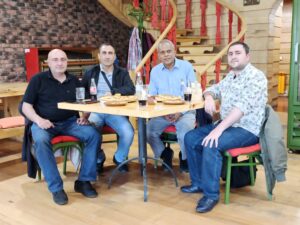
A few days before the end of my all-too-brief tenure in Stepanavan, the FRRA team of Haik – EK1RR, Aram – EK6KW, and Hovhannes – EK6RO drove down from Yerevan to visit me. After a cup of Armenian-style coffee prepared in a jazzve, the team set about evaluating and making improvements to the fan-dipole antenna. Their diagnosis was that the commercially manufactured balun was to blame. I remembered Dima’s gift. In a jiffy they made the switch and SWR levels were brought down to manageable levels. Homebrew trumped commercial! Unfortunately, my stay came to an end soon after and I could not do full justice to the efforts they had put in.
On the very last day of my operations, when I had given up all hope of logging an EK, out of the blue, I heard Armenian being spoken on the 15-meter band, loud and clear – an easy 59+. Can’t tell you how sweet Armenian sounded on the ham bands! This was my chance, I thought, to snag an EK. But the strong Armenian-speaking station happened to be not in Armenia but in Rostovskaya Oblast in Russia. It was Arut – R6LNI. I could barely hear the other station he was chatting with, Hovik – EK6TA, in Armenia. When I broke in and they heard my callsign, they were as excited as I was and were kind enough to QSY to 20 meters and we just about managed to exchange enough of the essentials to record a valid QSO between our two EKs. On the very last day! They do serve those who stand and wait.
In hindsight one of the best things that I did was to set up EK/AB1F accounts in LoTW, QRZ.com, eQSL.cc, Club Log, and Hamlog.online before I left the US. This enabled me to upload with ease the daily log every evening (and even several times a day on the big days) to the delight of the stations that had had a QSO with me. The increase in online confirmations, especially the use of LoTW outside of the US, is gratifying. But the highest percentage was for Hamlog.online, which Russian (and other) stations use for RDA confirmation – a whopping 75%!

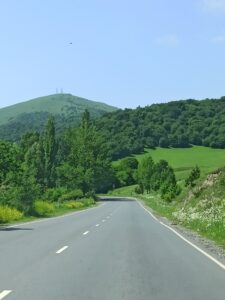 How was Armenia really? As a lover of Armenia, I am surely biased. But the time I spent there was truly a blessing after the long absence from that country during the pandemic years. In the US, in recent months, I have had to switch from tap water to bottled water but in Armenia I could drink straight from the tap. The irony was not lost on me. The local khorovats (shashlik) shop was only a five-minute walk from my station. For just $5 there was enough barbecued meat and potatoes for two full meals. The vegetable store and the supermarket were only another five minutes from the khorovats place. The non-GMO, hormone and additive-free meat, vegetables, and fruits were a delight. The outstanding Armenian wine, at a fraction of the American price and twice the quality, was a bonus at the end of working a pile-up.
How was Armenia really? As a lover of Armenia, I am surely biased. But the time I spent there was truly a blessing after the long absence from that country during the pandemic years. In the US, in recent months, I have had to switch from tap water to bottled water but in Armenia I could drink straight from the tap. The irony was not lost on me. The local khorovats (shashlik) shop was only a five-minute walk from my station. For just $5 there was enough barbecued meat and potatoes for two full meals. The vegetable store and the supermarket were only another five minutes from the khorovats place. The non-GMO, hormone and additive-free meat, vegetables, and fruits were a delight. The outstanding Armenian wine, at a fraction of the American price and twice the quality, was a bonus at the end of working a pile-up.
It was a relief to consciously avoid watching television for the entire time I was in Armenia. I do not think I missed anything significant. If anything, I had greater peace of mind and inner calm. Peace also came from experiencing a higher quality of life; one of mutual respect bordering on affection even from strangers. From watching grandparents and grandchildren enjoying each other’s company in the mornings and evenings. From watching children playing and running errands outdoors without any accompanying adults. From being wished Barev (hello) on the streets and from hearing Shnorhakalutyun (thank you) said often. The incredible stillness and quietness, save the buzzing of the bees. The sight of snow on peaks in summer. I could go on …
I am deeply, deeply grateful to my friend, AA, and her mother, who made their house available for this adventure and also found me an able support team to help with the antennas. Thank you both for making my amateur radio dream come true. Thanks also to Ike – W3IKE and to Haik – EK1RR and his team at FRRA.
If all goes well, I hope to return to Armenia for another innings as EK/AB1F.
Thank you! Shnorhakalutyun! 73!
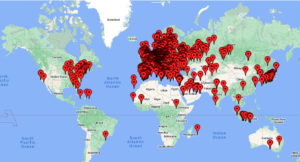


Awesome! Thanks again for the LOTW confirmation for EK Abe. Ken, KP4AA
Thanks, Ken! You were the first NA I worked and I had to ask you twice to make sure I wasn’t imagining things. 🙂
Hello Abie!
Thanks for the interesting story!
I hope to meet again!
73! de EK/RX3DPK
Thank you, Dima! Большое спасибо, Дима! 73
You have some really good ham buddies to help you out! I like your writhing style.
de VU3HZW
Thank you!
Barev Abie, it is a great story, congrats! Hats off to your support team in Armenia.
BTW my dad was originally from Stepanavan, even though I haven’t been to the place for 30+ years.
73 de Sergey NM6S
Barev Sergey jan! Yes, I remember your connection to Stepanavan from our email exchange at the start of my trip. Hope you will visit Armenia some time soon. Thanks for reading! 73 de AB1F
Thanks a lot for sharing the wonderful story of operating a portable station from beautiful Armenia. I am happy that I could manage a QSO with you. It’s heartening to know that so many hams from various places were eager to help you and collaborate. Long live the ham fraternity . 73
Atanu, VU2ATN
Thank you! I was very glad to make that 10 meter QSO with you from EK land. 73!
Abie, Very great and thorough article. Nicely done. 73 Ike W3IKE/K3ZQ
Thank you, Ike! I couldn’t have done this without your help and support. Hope you will come along the next time. 73 de EK/AB1F